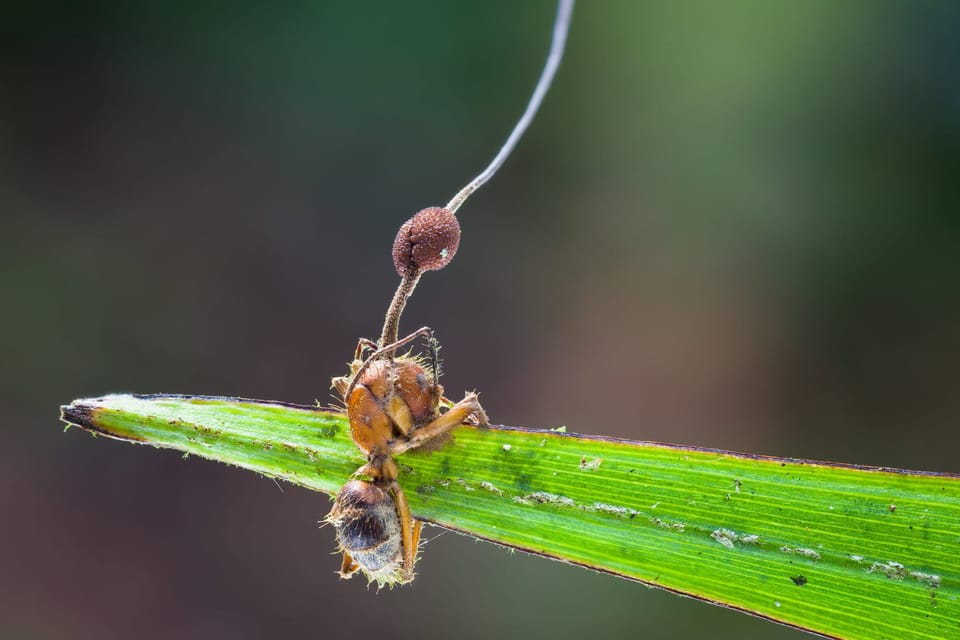The fascinating fungal science behind 'The Last of Us'

The following is a guest post by Michael Werner, a biology professor at the Unviersity of Utah. Werner shares this newsletter’s passion for communicating about science through the lens of science fiction, and he recently spoke with two fungal scientists in his department to discuss the popular HBO show ‘The Last of Us’. For more of Werner’s work, check out www.werner-lab.org.
***
The premise of the hit HBO show ‘The Last of Us,’ based on the popular video game with the same name, is that a fungal disease turns people into raving mushroom zombies. Admittedly, that sounds like it would target a narrow audience. But like all good sci-fi, The Last of Us, which returns for its second season in 2025, uses a fictional backdrop as a vehicle to illuminate the human condition. Also like most good sci-fi, there’s a fascinating scientific basis to it.
To help unpack that science, I recently sat down with two fellow biologists from the University of Utah: Jessica Brown, who studies a pathogenic fungus called Cryptococcus neoformans, and Bryn Dentinger, who leads a research program using molecular tools to study fungal diversity. We discussed what the show got right, what it got wrong, and the ultimate question: Could a mind-controlling fungal pandemic actually happen?
The following conversation has been edited for clarity and brevity:
Michael Werner: The fungus depicted in the ‘Last of Us’ is referred to as cordyceps. What is cordyceps, where does it live, and why did it inspire a zombie video game and show?
Bryn Dentinger: Cordyceps belong to a family of fungi that live primarily in tropical forests. The reason cordyceps is used for the basis of a zombie-like disease is that they infect arthropod hosts and affect their behavior in a peculiar way. The most well-studied example is Ophiocordyceps unilateralis, which infects ants and causes summit disease. When infected, the ant is seemingly under the control of the fungus. It climbs up a plant to a specific height and then bites down on a leaf. At the moment of biting down, chemicals released by the fungus dissolve the muscle fibers in the ant’s jaws, effectively locking it in place. Then things really go south for the ant, as the fungus consumes it from the inside. Eventually, it extends a long structure called a stroma from the ant’s head, which releases fungal spores to be carried by the wind. This is the ultimate goal of the whole macabre series of events: to maneuver the ant to a high enough point so that it can disseminate its spores to infect more ants.
This complicated pathogenesis is no accident. Cordyceps has evolved highly specific mechanisms for infection, behavioral rewiring, and dispersal. As to whether cordyceps could infect humans, the answer is highly unlikely, and the reason lies precisely in this complexity. Other cordyceps species will infect other arthropods such as spiders and wasps, but jumps between hosts are rare. Even jumping between different ant species is rare. The complicated mechanism of infection – luckily for us – comes at the cost of being able to infect multiple hosts.
Interestingly, humans actually cultivate cordyceps and sell it as a natural medicine and food. In fact, I’ve seen it sold in grocery stores. To be clear though, there are no scientific data to support the health benefits of eating cordyceps.
Michael: Are there ways the ants fight back? Have they evolved defenses against the fungus?
Bryn: It turns out that ants can recognize an infected ant, and physically quarantine it away from the rest of the colony.
Michael: Ants quarantine too!
Let’s transition to fungal pathogens that infect us. Jessica, what can you tell us about their prevalence and severity?
Jessica Brown: Of the 3 to10 million species of fungi, about 300 can cause disease in humans, and 30 routinely do. There are two main categories: The first is environmental, which can infect us when exposed at high dose but otherwise have their own life in soil or trees. The other category is commensals, which live on our skin and gut without disease symptoms.
Regarding severity, if we’re talking about non-life threatening but inconvenient diseases like athlete’s foot, we’re looking at 1 billion people. If we’re talking about deaths, we’re looking at 1.6 million people annually. Most of the deaths are associated with patients with underlying conditions. Untreated, Cryptococcus infections are horrific – essentially 100% mortality. Even treated, it's 30 to 70%. There is essentially no human-to-human transmission though, so in this sense the science doesn’t support “The Last of Us” premise.
Outbreaks do happen though. There was recently an outbreak of Blastomyces associated with a paper mill in Michigan. It seems that a tree infested with spores was processed by the mill causing over 100 confirmed infections and at least one death. Closer to home, in 2001 there was an outbreak of Coccidioides immitis in Dinosaur National Monument that infected an archeological team. It's to the credit of the doctors that they correctly diagnosed the infection, because C. immitis is not normally found this far north. In fact, it’s part of a growing trend that fungi from hotter and drier climates are being found further north, presumably due to climate change.
Michael: Are there any fungi that are beneficial?
Bryn: Fungi are “chemical wizards” and produce tons of powerful chemicals. One in particular is arguably the most important class of chemical ever discovered: the first antibiotic, penicillin. Other fungal chemicals include cholesterol-lowering statins and psilocybin - the psychedelic in “magic mushrooms”.
Michael: Ah, so there are fungi that can affect human behavior…
Bryn: Indeed! Along those lines, single-cell fungi, or yeast, are used to generate alcohol. Because of this, we culture enormous populations of yeast. From an evolutionary perspective, it could be argued that we are the agents of their propagation…
Michael: So, there’s no need to turn us into mushroom zombies—all fungi need to do is keep producing alcohol.